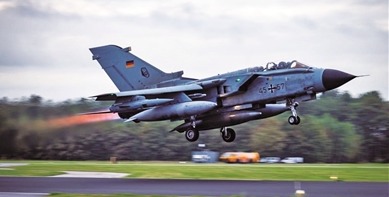By Jun Yu

A Germany's Panavia Tornado fighter-bomber takes off from Volkel Air Base in the Netherlands for air tasks during the Steadfast Noon nuclear exercise.
It is reported that from October 13 to 24, NATO conducted its annual nuclear exercise codenamed Steadfast Noon in several European countries and the airspace over the North Sea. This exercise not only set a new record for the scale of participation in history, but also rehearsed the coordinated employment of air-based nuclear forces and conventional strike forces in a nuclear war scenario for the first time. According to some analysts, amidst the current complex security situation in Europe, NATO's intention of amplifying the extended nuclear deterrence effect through the exercise will further intensify the arms race in the region.
Increasing nuclear strike forces
The North Sea was designated as the center of the operational area of the exercise, with Volkel Air Base in the Netherlands serving as its main hub. The exercise was commanded by the Nuclear Planning Group (NPG) of NATO's Supreme Headquarters Allied Powers Europe (SHAPE) located in Belgium, and involved 14 NATO member states including the US, the UK, and Germany. More than 2,000 troops were deployed to the exercise, along with participating equipment covering 13 types of platforms, including bombers, fighters, Airborne Warning and Control System (AWACS) aircraft, and tankers, such as F-35A fighters and B-52H strategic bombers from the US, and 71 combat aircraft from Germany, such as the Panavia Tornado fighter-bombers capable of carrying tactical nuclear bombs.
Of note is that in addition to the Tornados and B-52H strategic fighter bombers, F-35A fighter jets are also capable of carrying tactical nuclear bombs to conduct strike tasks. Compared with the configuration of air-based nuclear carriers in previous exercises, this exercise employed significantly more nuclear strike forces.
The exercise proceeded in three phases. The first was the operational briefing and planning phase. The second phase involved nuclear strike and defense drills, mainly focusing on nuclear weapon operations and ground nuclear asset protection. F-35A fighters and Tornado fighter bombers capable of tactical nuclear strikes, after completing nuclear bomb transport and loading, flew to the airspace over the North Sea under the escort of AWACS aircraft and Gripen fighters for at least three rounds of simulated nuclear strike training. The third phase was assessment and review. According to NATO Secretary General Mark Rutte, the Steadfast Noon nuclear exercise aimed to ensure the credibility, safety, and effectiveness of NATO's nuclear deterrence, and deliver to any potential adversary the signal of NATO's ability to defend all Allies against all threats.
Amplifying the nuclear deterrence effect
Some foreign media analysts believe that the exercise highlights two major shifts in NATO’s nuclear strategy.
First, it emphasizes "collective actions" to abandon the old model of reliance on the nuclear assets of the US and the UK, with other countries playing secondary supporting roles. With the Netherlands taking the lead, all the 14 countries were assigned refined division of labor in the exercise. According to Jim Stokes, NATO's Director of Nuclear Policy, if the conventional fighters and other combat elements capable of carrying out nuclear missions had been integrated within the Alliance, it would be possible to further enhance the integrated extended deterrence capabilities.
Second, it aims to amplify the nuclear deterrence effect through the "war rehearsal". According to Daniel Bunch, Chief of Nuclear Operations at SHAPE, the vision of this exercise was more aligned with the reality of Europe's security situation and the trend of future operations. By increasing the number of drill subjects and deliberately raising the complexity of response, it aimed to examine the readiness of the nuclear weapons and their practical utility under complex operational environments.
Inhibiting regional stability
Many parties are worried that this exercise will aggravate the shadow of nuclear war over Europe. A foreign media outlet pointed out that the Steadfast Noon nuclear exercise has continued for 10 consecutive years. With the increase in participating countries and the expansion of military forces, NATO continues to practice and optimize its nuclear weapon employment mechanism, and strengthen the nuclear sharing and extended nuclear deterrence. Development of this kind will prompt European countries to follow suit and adopt relevant capability development, thereby intensifying the regional nuclear arms race.
More importantly, while the Treaty Between the United States of America and the Russian Federation on Measures for the Further Reduction and Limitation of Strategic Offensive Arms will expire in early 2026, the two sides have not yet reached a clear consensus on its renewal. The US recent export of Tomahawk cruise missiles to Eastern European countries and the trial launch of Minuteman III Intercontinental Ballistic Missile (ICBM) have raised concerns in the international community about nuclear proliferation. NATO's course of continuing the Steadfast Noon and other nuclear exercises under the current background will further amplify the nuclear security risk and pose a threat to regional peace and stability.



